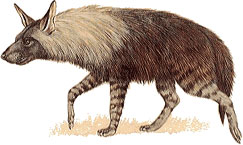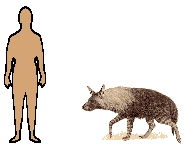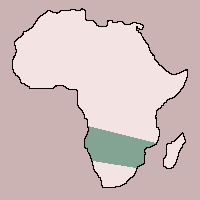Brown Hyena

| Class: Mammalia:
Mammals |
Diet: Carrion |
| Order:
Carnivora: Carnivores |
| Size: body:11.1
- 1.2 m (3 1/2 - 4 ft), tail: 25 - 30 cm (9 3/4 - 11 3/4 in) |
| Family: Hyaenidae:
Hyenas |
Conservation Status: Near threatened
|
| Scientific Name:
Hyaena brunnea |
Habitat: dry savanna,
plains, semidesert |
| Range:
Africa: Angola to Mozambique, south to Northern South Africa |
 Typical
of its family, with a bulky head and back sloping toward the rear, the
brown hyena has long, rough hair over much of its body, with a mane of
even longer hair on the neck and shoulders. This hyena is usually dark
brown to brownish-black in color, with a lighter-brown mane and legs. Unless
in a family group, the brown hyena is solitary, but it sometimes gathers
with others in a hunting pack or at a big carcass. It lives in a large
territory, which it marks with secretions from anal scent glands and with
feces. Typical
of its family, with a bulky head and back sloping toward the rear, the
brown hyena has long, rough hair over much of its body, with a mane of
even longer hair on the neck and shoulders. This hyena is usually dark
brown to brownish-black in color, with a lighter-brown mane and legs. Unless
in a family group, the brown hyena is solitary, but it sometimes gathers
with others in a hunting pack or at a big carcass. It lives in a large
territory, which it marks with secretions from anal scent glands and with
feces.  During the day, the brown hyena sleeps among rocks or tall grass. Otherwise,
it may find a burrow, often one left by another animal, such as an aardvark.
It emerges at night to find carrion or to hunt prey such as rodents, birds,
including poultry, reptiles or wounded large animals. Near the coast, brown
hyenas also feed on dead fish, mussels and the stranded corpses of seals
and whales. A litter of 2 to 4 young is born in a burrow after a gestation
of 92 to 98 days. The young are suckled for about 3 months but remain with
their parents for up to 18 months, during which the male brings them food.
Although protected in game reserves, brown hyenas are considered pests
because of their habit of attacking livestock, and large numbers have been
killed by farmers.
During the day, the brown hyena sleeps among rocks or tall grass. Otherwise,
it may find a burrow, often one left by another animal, such as an aardvark.
It emerges at night to find carrion or to hunt prey such as rodents, birds,
including poultry, reptiles or wounded large animals. Near the coast, brown
hyenas also feed on dead fish, mussels and the stranded corpses of seals
and whales. A litter of 2 to 4 young is born in a burrow after a gestation
of 92 to 98 days. The young are suckled for about 3 months but remain with
their parents for up to 18 months, during which the male brings them food.
Although protected in game reserves, brown hyenas are considered pests
because of their habit of attacking livestock, and large numbers have been
killed by farmers.
  
|

